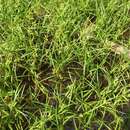Comments
(
englanti
)
tarjonnut eFloras
Carex schweinitzii is very local and uncommon but often forms large colonies where present. It hybridizes occasionally with C. hystericina. The single, old Missouri collection (G. Yatskievych 1999+) seems so far disjunct as to suggest that there may have been a label mixup.
- lisenssi
- cc-by-nc-sa-3.0
- tekijänoikeus
- Missouri Botanical Garden, 4344 Shaw Boulevard, St. Louis, MO, 63110 USA
Description
(
englanti
)
tarjonnut eFloras
Plants extensively colonial; rhizomes long. Culms trigonous in cross section, 18–65 cm, smooth distally. Leaves: basal sheaths pale brown; ligules as wide to wider than long; blades pale to mid green, flat to W-shaped, 4–11 mm wide, glabrous. Inflorescences 8–24 cm; proximal bract 11–37 cm, exceeding inflorescence; proximal 2–4 spikes pistillate, erect or often the proximal ascending to spreading; terminal 1(–2) spikes staminate. Pistillate scales lanceolate-acuminate, 2.4–6.9 × 0.3–0.9 mm, shorter than or the proximal longer than perigynia, margins serrulate-ciliate, apex with prominent scabrous awn. Staminate scales acute to acuminate, smooth except at tip. Perigynia ascending, 7–11-veined, narrowly elliptic, 4.2–7 × 1.3–1.8 mm, apex tapered; beak 1.4–2.4 mm, bidentulate, smooth, teeth straight, 0.2–0.5 mm. Stigmas 3. Achenes pale brown, trigonous, smooth.
- lisenssi
- cc-by-nc-sa-3.0
- tekijänoikeus
- Missouri Botanical Garden, 4344 Shaw Boulevard, St. Louis, MO, 63110 USA
Distribution
(
englanti
)
tarjonnut eFloras
Ont.; Conn., Mass., Mich., Mo., N.Y., Pa., Vt., Va., Wis.
- lisenssi
- cc-by-nc-sa-3.0
- tekijänoikeus
- Missouri Botanical Garden, 4344 Shaw Boulevard, St. Louis, MO, 63110 USA
Habitat
(
englanti
)
tarjonnut eFloras
Shallow cold streams, springheads, seeps, margins of fens, and seepy stream, pond, and lakeshores in open or lightly shaded sites, in highly calcareous soils; 100–600m.
- lisenssi
- cc-by-nc-sa-3.0
- tekijänoikeus
- Missouri Botanical Garden, 4344 Shaw Boulevard, St. Louis, MO, 63110 USA
Comprehensive Description
(
englanti
)
tarjonnut North American Flora
Carex schweinitzii Dewey; Schw. Ann. Lye. N. Y. 1 : 71. 1824
"Carex Schweinitzia Dewey" Eaton, Man. ed. 5. 159. 1829. (Change of form of name.)
Loosely cespitose and stoloniferous, the stolons numerous, long, horizontal, slender, tough, the culms 2.5-7.5 dm. high, stoutish, stiff, erect, exceeded by the bracts and often by the upper leaves, aphyllopodic, sharply triangular and smooth to very rough above, light-brownishtinged at base, the dried-up leaves of the previous year conspicuous; leaves with well-developed blades 3-7 to a fertile culm, not clustered, septate-nodulose, the blades yellowish-green or light-green, thinnish, stiff, fiat with slightly revolute margins, usually 2-3 dm. long, 5-10 mm. wide, rough toward the apex, the sheaths rather loose, white-hyaline ventrally, truncate at mouth, the ligule short, wider than long; staminate spike solitary, erect, slender-peduncled, usually with a conspicuous bract or a smaller sessile spike some distance below, 2.5 cm. long, 2.5 mm. wide, the scales oblong-obovate or oblanceolate, little ciliate, cuspidate or acute, light-reddish-brown-tinged with green midrib and very narrow hyaline margins; pistillate spikes 2-5, approximate to strongly separate, the lower on short or occasionally long peduncles, erect or somewhat recurving-spreading, the upper erect on short peduncles or nearly sessile, the peduncles slender, rough, the spikes narrowly cylindric, 2.5-9 cm. long, 8-14 mm. wide, closely flowered above, more loosely below r , containing numerous spreading or somewhat ascending perigynia in several rows, the spikes occasionally somewhat compound at base; lower bracts leaf-like, exceeding inflorescence, more or less strongly sheathing, the upper reduced; scales with short, oblong-ovate, non-ciliate bodies, with hyaline or somewhat reddishbrown-tinged margins and green 3-nerved center excurrent as a long rough awn, the bodies narrower than and several times shorter than the perigynia; perigynia narrowly ovoid, 5-7 mm. long, 1.5-2 mm. wide, suborbicular in cross-section, inflated, membranaceous, puncticulate, smooth, shining, light-green or straw-colored at maturity, coarsely several-ribbed, roundtapering at base, short-stipitate, tapering into a slender, smooth bidentate beak 1.5-2 mm. long, the short, slender, stiff teeth erect or somewhat spreading, 0.5 mm. long; achenes small, obovoid, 1.5-1.75 mm. long, 1 mm. wide, triangular with concave sides and blunt angles, brownish, granular, sessile, abruptly contracted at apex and continuous with the persistent, slender, flexuous style; stigmas 3, slender, light-brown, short.
Type locality: "Massachusetts"; and more specifically: "Grows in wet sandy soil at the foot of the descent to the alluvial of the Hoosick in this place, and Pownal, Vermont." (Dewey, Am. Jour. Sci. 9:68.)
Distribution: Swamps or springy banks in calcareous districts, Vermont to southern Ontario and northern Michigan, and southward to northwestern Connecticut, northwestern New Jersey, North Carolina, Tennessee, and Missouri. A very local species. (Specimens examined from Vermont, Massachusetts, Connecticut, New York, Ontario, Michigan, North Carolina, Tennessee, Missouri.)
- bibliografinen lainaus
- Kenneth Kent Mackenzie. 1935. (POALES); CYPERACEAE; CARICEAE. North American flora. vol 18(7). New York Botanical Garden, New York, NY

